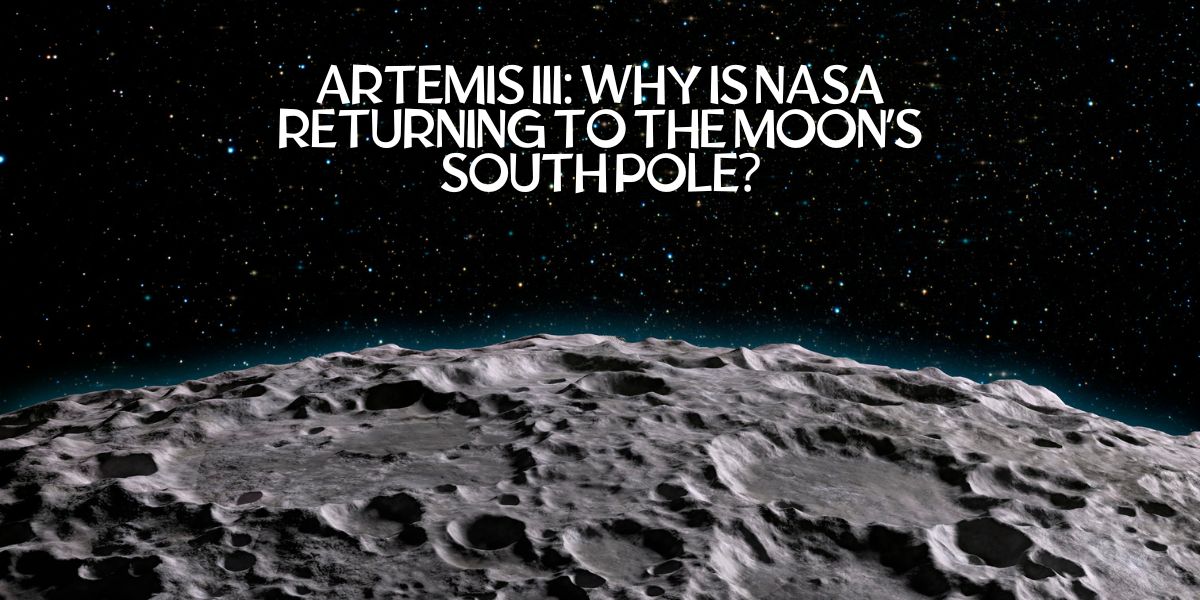Have you ever looked at the Moon and wondered what it would be like to walk on it? NASA is making that dream real again with Artemis III, a mission that will send astronauts back to the Moon for the first time in over 50 years. But this time, they are going somewhere new, the Moon’s South Pole.
Why the South Pole? Scientists believe this area has something very special, water ice hidden in dark, cold craters. Water is essential for life, and if we find enough of it, future astronauts could use it for drinking, growing plants, or even making rocket fuel! This mission is a big step toward humans living and working on the Moon.
So, why is NASA so interested in this icy, shadowy part of the Moon? Let’s find out!
Why Is NASA Going Back to the Moon?
NASA’s last Moon landing was in 1972 with Apollo 17. Since then, technology has improved, and new discoveries have made the Moon even more exciting. The Artemis program aims to:
- Explore new areas of the Moon, like the South Pole.
- Learn how to live in space for longer periods.
- Prepare for future Mars missions by testing new technology.
The Moon is like a practice ground before sending humans to Mars. By learning how to survive there, NASA can make space travel safer and easier.
What’s Special About the Moon’s South Pole?
The Moon’s South Pole is not like the flat, dusty areas where Apollo astronauts landed. It has:
- Deep, dark craters where sunlight never reaches.
- Possible ice deposits in these cold shadows.
- Long periods of sunlight on some high ridges, which is good for solar power.
Scientists think these ice deposits could be millions of years old. If astronauts can use this water, it would save NASA from bringing it from Earth, making space missions cheaper and more sustainable.
How Will NASA Land Astronauts on the Moon’s South Pole?
Landing on the Moon’s South Pole is tricky because:
- The terrain is rough, with big rocks and deep craters.
- Sunlight is limited, making navigation harder.
NASA’s Space Launch System (SLS) rocket will send the Orion spacecraft toward the Moon. Then, a special lunar lander (like SpaceX’s Starship) will take astronauts from orbit down to the surface.
Once there, astronauts will:
- Collect ice samples to study.
- Set up science experiments to learn about the Moon’s environment.
- Test new spacesuits designed for extreme cold.
Will Humans Live on the Moon One Day?
Artemis III is just the beginning. NASA plans to build a lunar base called the Artemis Base Camp in the future. This could allow:
- Scientists to stay for weeks or months doing research.
- Astronauts to train for Mars missions.
- Mining water ice to make fuel and oxygen.
If successful, the Moon could become a stepping stone for deeper space exploration.
When Will Artemis III Launch?
As of June 2025, NASA is preparing for Artemis III to launch in late 2026 or early 2027. This mission will be historic because:
- It will be the first crewed Moon landing since 1972.
- The first woman and first person of color will walk on the Moon.
- It will test new technology for future space travel.
Delays can happen, but NASA is working hard to make this mission a success.
Conclusion: A New Era of Moon Exploration
Artemis III is not just about going back to the Moon, it’s about staying there. By exploring the South Pole, NASA hopes to unlock secrets that could help humans live in space one day. Water ice, new technology, and scientific discoveries will shape the future of space travel.
What do you think, will we see a Moon base in your lifetime?
📌 Frequently Asked Questions
Why is the Moon’s South Pole so important?
The South Pole may have water ice in its dark craters. Water is crucial for drinking, growing plants, and making rocket fuel.
Who will be on the Artemis III mission?
NASA has not yet announced the crew, but it will include the first woman and first person of color to walk on the Moon.
How long will astronauts stay on the Moon?
Artemis III astronauts will stay for about one week, conducting experiments and exploring.
Can we breathe on the Moon?
No, the Moon has no air. Astronauts will need spacesuits and oxygen tanks to survive.
How cold is the Moon’s South Pole?
Some areas are as cold as -250°C (-418°F) because they never get sunlight.
Will Artemis III use the same technology as Apollo?
No, Artemis III uses new rockets, landers, and spacesuits designed for modern exploration.
How will astronauts get water from the Moon?
They will drill or scoop ice from shadowed craters and melt it into liquid water.
What’s next after Artemis III?
NASA plans Artemis IV and beyond, leading to a permanent Moon base.
Can tourists go to the Moon one day?
Maybe! Companies like SpaceX are working on private Moon missions in the future.
How far is the Moon from Earth?
The Moon is about 384,400 km (238,855 miles) away—about 30 Earths lined up!
